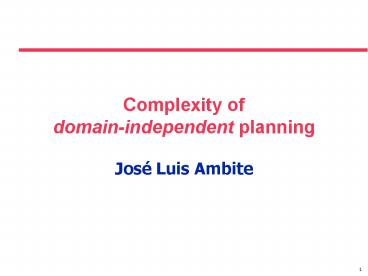Complexity of domainindependent planning - PowerPoint PPT Presentation
1 / 15
Title:
Complexity of domainindependent planning
Description:
Decision problem: a problem with a yes/no answer e.g. 'is N prime? ... Semi-decidable: if program halts with correct answer in one of the cases (either ' ... – PowerPoint PPT presentation
Number of Views:47
Avg rating:3.0/5.0
Title: Complexity of domainindependent planning
1
Complexity of domain-independent planning
- José Luis Ambite
2
Decidability
- Decision problem a problem with a yes/no answer
e.g. is N prime? - Decidable if there is a program (i.e. a Turing
Machine) that takes any instance and correctly
halts with answer yes or no. - Semi-decidable if program halts with correct
answer in one of the cases (either yes or no)
but not in the other case (goes on forever) - Undecidable There is no algorithm to solve the
problem. Ex Halting Problem.
3
Undecidability (Intuition)
- There are more problems than solutions!!!
- Turing Machine
- Can be encoded as an integer
- gt Countably Many (N )
- Problem
- Mapping from inputs (N ) to outputs (N )
- gt Uncountably Many (R 2N)
4
Planning Decision Problems
- Plan Existence (PLANSAT)
- Given a planning problem instance P (I, O, G),
- Is there a plan that achieves goals G from
initial state I using operators from O? - Plan Length (PLANMIN)
- Given a planning problem instance P (I, O, G)
and an integer k (encoded in binary), - Is there a plan that achieves goals G from
initial state I using less than k operators from
O ?
5
Decidability results from Erol et al 94
xxx xxx
6
Decidability results from Erol et al. 94
- Exploits relationship between planning and logic
programming. - Can transform a planning problem without delete
lists or negative preconditions to a logic
program (and vice versa) in polynomial time - R1 a ? b1 ? b2 ? b3
- Op_R1 pre b1, b2, b3 add a del
- function symbols gt undecidable
- unless have acyclicity and boundedness
conditions. - No function symbols and finite initial state gt
decidable
7
Worst-case Complexity of Problems
- If a problem is decidable, we might ask how many
resources a program requires to compute the
answer (in the worst case). - We measure the resources a program takes in terms
of time or space (memory), as a function of the
size of the input. - If a problem is known to be in some complexity
class, then we know there is a program that
solves it using resources bound by that class.
8
Complexity Classes
- A problem is in P if ? program to decide it
taking polynomial time in the size of the input. - A problem is in NP if ? nondeterministic program
that solves it in polynomial time. - program makes polynomially-many guesses to find
the correct answer (solution check also P). Ex
SAT. - A problem is NP-Complete if any problem in NP can
be reduced to it. Ex SAT - PSPACE polynomial space. Ex QSAT
- EXP, EXPSPACE exponential time, space
- NEXP nondeterministic exponential time, etc.
9
Hierarchy of Complexity Classes
Undecidable
Decidable
PSPACE ? EXPSPACE
EXPSPACE
P ? EXP
NEXP
PSPACE NPSPACE
EXP
PSPACE
P ? NP ? PSPACE
NP
P ? NP
P
10
States, operators, plans. How many, how big?
- Assume no function symbols, finite states,
n objects, m predicates with arity r, and o
operators (with s variables max each) - Possible atoms p m nr
- gt Each state requires exponential space
- Possible states Powersetp 2p
- gt State space is double exponential
- Possible ground operators o ns
- In general plans will be bounded by the number of
states. (Why?)
11
Complexity bounds for decidable
domain-independent planning
- With no restrictions EXPSPACE
- Search through all states
- Each state consumes exponential space
- No delete lists NEXP
- operators only need to appear once
- Choose among exponentially-many operators
- No negative preconds and no deletes EXP
- Plans for different subgoals wont negatively
interfere with each other gt order does not
matter (no choose)
12
Propositional Planning
- Propositions 0-ary predicates
- State has p propositions (polynomial)
- Possible States Powersetp 2p (single!
exponential) - Number of Operators is also polynomial
- gt Reduced complexity
- General case from EXPSPACE to PSPACE
- No deletes from NEXP to NP
- No deletes and no negative preconds from EXP to
P - If you know the operators in advance, this in
effect bounds the arity of predicates and
operators, with the same result
13
Propositional PLANSAT
Bylander94
14
Propositional PLANMIN
- If PLANSAT was PSPACE(NP)-complete, PLANMIN is
also PSPACE(NP)-complete
15
What does all this mean?
- Domain-independent planning in general is very
hard PSPACE, NP, - Even for very restricted cases
- 2 positive preconds, 2 effects (PSPACE)
- 1 precond, 1 positive effect (NP)
- in the worst case
- What about the average case, structured domains,
real-world problem distributions? - gt Heuristics, reuse solutions, learning































